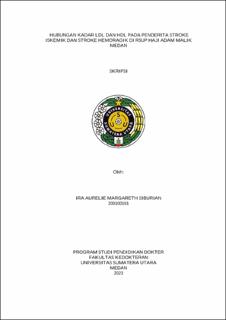Hubungan Kadar LDL dan HDL Pada Penderita Stroke Iskemik dan Stroke Hemoragik di RSUP Haji Adam Malik Medan

Date
2023Author
Siburian, Ira Aurelie Margareth
Advisor(s)
Nasution, Irina Kemala
Metadata
Show full item recordAbstract
Introduction. Stroke is the second leading cause of death worldwide, according to the WHO (2020). It is a condition caused by disturbances in cerebral blood circulation, potentially leading to paralysis and death. Dyslipidemia, a disorder of fat metabolism manifested by an increase or decrease in blood plasma lipid levels, is one of the risk factors for stroke. Objective. This study aims to determine the relationship between LDL and HDL levels in ischemic and hemorrhagic stroke patients at RSUP Haji Adam Malik Medan. Methods. This retrospective analytical study used a cross-sectional design. The study population included ischemic and hemorrhagic stroke patients at RSUP Haji Adam Malik Medan in 2022. Data analysis employed multivariate techniques to observe frequency distribution and inter-variable relationships. Results. The study involved 70 stroke patients. The majority of ischemic stroke patients were in the age group of 51-65 years (51.4%) and were predominantly male (57.1%). In hemorrhagic stroke, most patients were in the 51- 65 year age group (45.7%) and were predominantly female (65.7%). The Batak ethnic group was the most common in both ischemic (60%) and hemorrhagic (54.3%) stroke patients. The average LDL level in ischemic stroke patients was 176.40 mg/dl and HDL was 34.83 mg/dl, while in hemorrhagic stroke, the average LDL was 123.09 mg/dl and HDL was 39.46 mg/dl. A significant relationship was found between LDL levels (p=<0.001) and HDL levels (p=<0.001) in ischemic and hemorrhagic stroke patients. Conclusion. There is a significant relationship between LDL and HDL levels and ischemic and hemorrhagic stroke patients at RSUP Haji Adam Malik Medan in 2022.
Collections
- Undergraduate Theses [2259]
